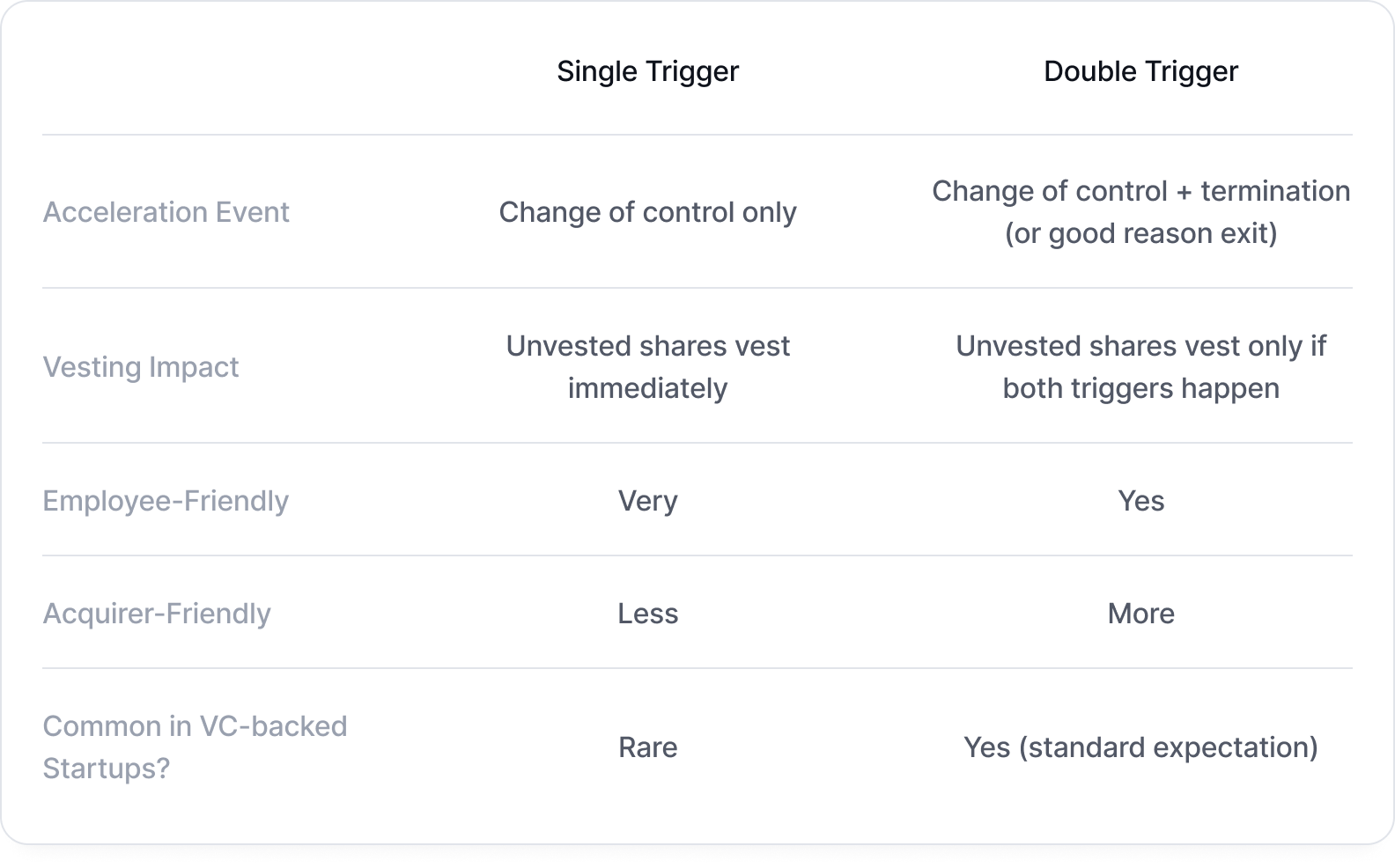
Double vs Single Trigger Acceleration in ESOP: What Founders Should Know
If you’re putting together an Employee Stock Option Plan (ESOP) for your startup, you’ve probably come across terms like “single trigger” and “double trigger” acceleration. These can sound a bit legalistic at first, but they’re important if you want to make sure both your team and your company are protected in the event of a major change like an acquisition. Here’s a clear breakdown of what these terms mean, how they work, and how to decide which one fits your company best.
What Is Acceleration In an ESOP?
Acceleration refers to the process of speeding up the vesting of stock options. Normally, employees earn their equity over a 3 or 4-year vesting schedule with a 1-year cliff. But in some scenarios, especially during an acquisition or change of control, acceleration clauses can allow a portion (or all) of those unvested options to vest immediately. These clauses are often negotiated as part of offer letters or the company’s ESOP rules.
What Is Single Trigger Acceleration?
Single trigger acceleration means that some or all of an employee’s unvested shares vest automatically when a specific event occurs — most commonly a change of control, like the company being acquired.
For example, if a company is acquired two years into a four-year vesting schedule, a single trigger clause could allow the remaining unvested shares to vest in full upon acquisition, regardless of whether the employee continues working at the new company.
This mechanism is designed to reward employees for their contribution to reaching an exit and to ensure they don’t lose the value of their unvested shares during a sudden ownership change. However, while it provides immediate upside for employees, it can pose risks for acquirers. If all employees are fully vested on day one post-acquisition, they might be less incentivized to stay and contribute to the company’s future under new ownership.
Because of this, many acquirers negotiate to remove or reduce single trigger clauses during deal structuring. It’s also less common in VC-backed startups where long-term retention of the team is key.
What Is Double Trigger Acceleration?
Double trigger acceleration provides a more balanced solution. It requires two conditions to be met before any unvested shares accelerate:
- The company experiences a change of control (e.g. acquisition).
- The employee is either terminated without cause or resigns for a valid reason (such as a significant demotion, pay reduction, or forced relocation).
Under this structure, employees don’t automatically receive all their unvested shares upon acquisition. Instead, acceleration only happens if their role materially changes or they are let go within a specific period following the acquisition — often 12 months.
If only one of the two conditions is met, for example, the company is acquired but the employee remains in their position under the same or similar terms , then the acceleration doesn’t apply. In this case, the employee continues vesting according to the original schedule.
This approach ensures that employees are protected from losing unvested equity unfairly while also giving acquirers the confidence that key team members will remain engaged during the transition. It creates a built-in retention incentive while offering a safety net for the employee if things go sideways after the deal.
Double trigger clauses are now considered standard in most venture-backed startups and are often required by investors as part of best-practice governance.
Single vs Double Trigger: Key Differences
Here’s a quick comparison to help you understand the practical differences:

Which One Should You Choose?
For most early-stage startups, double trigger acceleration is the more practical and commonly accepted choice. It helps strike a fair balance between employee protection and deal flexibility. Founders and early team members still get equity protection in the event of a major exit, but acquirers aren’t discouraged by the risk of losing the entire team overnight.
Single trigger can work in smaller or bootstrapped companies where founders want to offer very strong upside to early hires, but it can create complications later during fundraising or acquisition negotiations.
Final Thoughts
Choosing the right acceleration structure in your ESOP shapes how your team sees their equity and how outside investors view your long-term structure. If you’re building for a high-growth future, aim for clarity and balance. In most cases, double trigger acceleration is the cleanest, most scalable solution.













